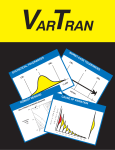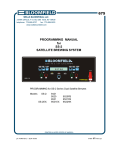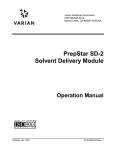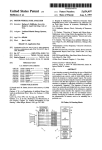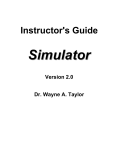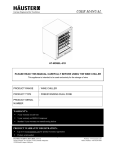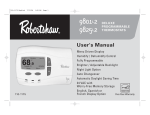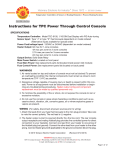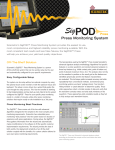Download Tutorial - Variation.com
Transcript
® VarTran 3.2 TUTORIALS: Guide to Getting Started 1 What is VarTran? VarTran is in one sense a tolerancing package. It can perform all the standard analysis including statistical tolerancing, worst-case tolerancing, and sensitivity analysis. But VarTran goes beyond the bounds of traditional tolerancing packages to address the selection of optimal targets for the inputs. This also makes VarTran a product/process optimization tool. In finding the optimal targets, VarTran considers the effects of the inputs on both the average and variation of the outputs resulting in a robust design. VarTran is also a robust design tool. Below are just some of VarTran’s capabilities: ♦ Optimize product or process performance: ♦ Maximize Cpk ♦ Minimize percent defective ♦ Minimize Taguchi loss ♦ Achieve robust designs ♦ Statistical tolerancing ♦ Worst-case tolerancing ♦ Process tolerancing (a unified approach to tolerancing) ♦ Find cause of variation (sensitivity analysis) ♦ Handles tough nonlinear problems ♦ Analytic methods of predicting variation that are much faster than performing simulations ♦ Optimization routines based on interval analysis that are guaranteed to find the global optimal ♦ Following designed experiments, use to: ♦ Optimize for production conditions rather than the conditions existing during the study ♦ Identify the root cause of the variation State of the Art Capabilities VarTran has many firsts. It introduces a unified approach to tolerancing called process tolerancing that incorporates both statistical and worst-case tolerancing. This allows statistical and worst-case tolerances to be mixed in the same analysis. It uses interval analysis optimization routines guaranteed of finding the global optimal. It uses analytic methods of predicting the variation, which are much faster than performing simulations. With VarTran, you can accomplish feats you never before dreamed of. Trial Period The downloaded software is the full version of VarTran but is limited to a 30-day trial period. At the end of this trial period, the functionality of the software is severely reduced. After the 30-day trial period, the program is limited to running previously created problems or problems restricted to a small number of variables. VarTran runs under any 32-bit version of Windows including Windows 95, Windows 98, Windows 2000, Windows XP and Windows NT. 2 After the trial period, the software can be restored to full functionality by registering the software at www.variation.com/vta and paying the $495 registration fee (subject to change). You will then be provided with a registration code that will restore it to full functionality. Further information is available from: Taylor Enterprise, Inc. 5510 Fairmont Rd., Suite A Libertyville, IL 60048 USA Phone: Fax: E-mail: Web Site: (847) 367-1032 (847) 367-1037 [email protected] www.variation.com Getting Started First download the file vta31.exe from www.variation.com/vta. Executing this file will install the software. It can be uninstalled at any time using the Windows control panel. To get a quick understanding of the software’s capability, select the tutorial below of greatest interest and turn to that section for step by step instructions. Design of a Pump: Demonstrates the use of VarTran in product development. Optimization of a Heat Sealer: Demonstrates the use of VarTran on a process following a response surface study. Dimensional Stack-up Problem: Demonstrates the variety of methods available in VarTran for addressing tolerance stack-up problems. VarTran as a Mathematics Package: Demonstrates VarTran's math capabilities including its state-of-the-art optimization routines based on interval analysis. Once acquainted with the software, you can try your own problem, as described in the last section, or you can explore some of the more advanced features of the software. Further information is readily available through VarTran's extensive help system and user manual. 3 TUTORIAL 1: DESIGN OF A PUMP 1.1 Introduction Design offers the first and best opportunity for reducing variation. To illustrate the strategies and tools required, consider the task of designing a new pump. Suppose that the pump must be capable of delivering solution at a constant rate of 10 ml/min. Customer usage requires that the flow rate remain between 9 and 11 ml/min. The first step is to develop a design concept. Taguchi calls this the system design. Suppose we decide to use a piston to push the solution. This concept requires a motor to drive the piston and a valve to control the direction of the flow. This is the creative part of design. Now the work begins. We need to determine all the specifics such as "How far should the piston travel?" and "How fast should the motor turn?" To accomplish this task, we need to make a list of all the factors affecting flow rate. Three obvious factors are the piston radius (R), the stroke length (L), and the motor speed (S). Another possible factor is the amount of backflow through the valves (B). Factors affecting flow rate are referred to as the input variables. Flow rate is referred to as the output variable. It is the output for which we want to optimize the average and reduce the variation. This is accomplished by establishing requirements and controls for the inputs. 1.2 Initial Design To accomplish our task, we must be able to predict how the output will behave. This requires knowledge of how the inputs behave and how the inputs affect the output. For a pump, it is possible to use geometry to derive the following equation for flow rate: F = (16.388 π R2 L - B) S The expression π R2 L represents the volume of a cylinder of radius R and height L. Multiplying by 16.388 converts the quantity from cubic inches to milliliters. The volume is then reduced by the backflow and multiplied by the motor speed to obtain the final flow rate. We also need information on how the inputs behave. This requires us to call the plant to obtain process capability information on drilling the piston hole. They tell us the standard deviation of their process is 0.0005". We must also call the motor supplier to determine the capability of their process in controlling motor rpm. They have both $5 and $20 motors. Our initial design will be based on lowcost components and processes so we request information on the $5 motor. Changes can be made later if necessary. They inform us that the standard deviation of their process is 0.17 rpm. The valve supplier must also be contacted to determine their process capability information for valve backflow. There is a choice between a $1 and a $2 valve. Again we start with the $1 valve. The valve manufacturer provides us with both an average and standard deviation. The table on the next page shows the information collected. 4 Data from Plants and Suppliers Inputs Average Standard Deviation Piston Radius (R) - 0.0005” Stroke Length (L) - 0.0017” Motor Speed (S) - 0.17 rpm Backflow (B) 0.05 ml 0.005 ml Targets must be selected for piston radius, stroke length and motor speed. Values of R = 0.1" and L = 0.5" were selected based on judgment. Plugging these values into the equation for flow rate, setting the equation equal to 10 ml/min and solving for motor speed results in a motor speed of 48.2 rpm. This completes the preliminary design. The average should be on target, but what about the variation? 1.3 Using VarTran For a demonstration of VarTran's abilities, start VarTran and open the file pump.vta. This is accomplished by selecting the Open... menu item from the File menu. Highlight pump.vta and then click on the OK button. The I/O System window shown below will be displayed. The input variables are shown on the left of the window and the output variables are shown on the right. All of the information about the input and output variables has already been entered into VarTran. To view the information entered for a variable, double click on it in the I/O System window. For example, double clicking on the output variable F displays the dialog box shown on the next page. This dialog box is used to enter the equation, target and specification limits for flow rate. Press the OK button to close the dialog box. 5 Try the same for the input variable R. The dialog box shown below is displayed. This dialog box is used to enter the target and standard deviation for R. A tolerance has been entered that is +/-3 standard deviations. The standard deviation is then specified as 1/6 the width of the tolerance. A maximum and minimum target has also been entered representing the range of alternative targets considered when optimizing the design later. The Include in Optimization check box is checked indicating that the target for this input can be changed during design optimization. Press the OK button to close the dialog box. 6 For input variable B (valve backflow), the Include in Optimization check box is not checked. This prevents the backflow target from changing during optimization. The target for backflow was provided by the supplier and cannot be adjusted by the designer. 1.4 Evaluating the Initial Design If you know how the inputs behave and you know how the inputs affect the output, you can predict how the output will behave. While this can be accomplished using a simulation, VarTran uses analytic methods instead. To view the results, click on the Capability Study button on the toolbar. This performs a tolerance analysis and displays the results shown below. Analysis – Capability Study In designing this pump, our goal is six sigma quality. This requires a defect rate of 3.4 defects per million (dpm) or below. The capability study predicts that the defect rate will be 297 dpm and that some pumps will have flow rates as low as 8.7544 and as high as 11.242 ml/min. Both these values are outside the specifications of 9 to 11 ml/min. The initial design does not achieve our six sigma goal. Since the flow rate average is on target, the variation must be reduced. Leave the Capability Study window open. 7 1.5 Robust Design One way of reducing the flow rate variation is through what Taguchi calls robustness. Robustness is obtained by designing the pump to be less sensitive to the variation of the inputs. The inputs continue to vary, but less of this variation is transmitted to the output. Robust design is accomplished through the setting of the inputs' targets. Since it is generally less costly to adjust targets than tighten tolerances, building in robustness is the preferred method of reducing variation. This is what Taguchi calls the second stage of design, which he refers to as Parameter Design. A robust design can be obtained by finding the set of targets for the inputs that minimizes the defect rate. Start by clicking on the Optimize button on the toolbar. The Find Optimal Targets dialog box shown below is displayed. Specify that the flow rate percent defective is to be minimized and then click on the Simplex Optimize button. The optimization will take just a couple of seconds. Analysis – Find Optimal Targets Once the optimization is completed, exit the Find Optimal Targets dialog box by clicking on the Close button. The Capability Study window will automatically update itself. It will now appear as shown on the next page. The variation has been cut in half while maintaining an average flow rate of 10 ml/sec. Since the defect rate is below 3.4 dpm, our design is now six sigma. The capability study predicts that nearly all units will fall in the range of 9.3224 to 10.678 ml/min. This is well within the specification limits. All this was accomplished using the low cost components. Your results may differ slightly due to the properties of the optimization routine but should be very close. 8 To view the new design, click on the Summary Table button on the toolbar. The result is shown below. The new targets are R = 0.1737", L = 0.40942" and S = 17.064 rpm. The target for valve backflow did not change because it was excluded from the optimization. It was provided by the supplier and cannot be adjusted by the designer. Variables – Summary Tables 9 1.6 Tightening Tolerances What if the desired performance had not been achieved? The next step would be to tighten tolerances. This generally requires using more expensive components and processes. The question is which tolerances and by how much? In deciding which tolerances to tighten, you should consider both the cost and the effect of tightening each tolerance. To determine the effect of tightening the tolerances on the different inputs, click on the Variation Pareto Chart button on the toolbar. The window shown below is displayed. Analysis- Variation Pareto Chart Motor speed variation (S) is the largest contributor to the flow rate variation. Tightening its tolerance requires using the $20 motor. One could enter the tolerance (standard deviation) for the $20 motor, reoptimize the process and then view the new capability. One should also consider tightening the tolerance for valve backflow. This requires using the $2 valve which is significantly cheaper. The Pareto chart indicates the effect is nearly the same as tightening the tolerance of motor speed. The option representing the best value to the customer should be selected. This is what Taguchi refers to as the third stage of design, which he calls Tolerance Design. 10 1.7 Summary The above example illustrates the following strategies: (1) The designer must take the time to identify: • • • • • The key outputs Customer requirements for the key outputs The key inputs How the key inputs behave (manufacturing and suppliers capabilities) How the key inputs affect the outputs (equations) Without this knowledge, the design process breaks down into one of trial and error. (2) Designing in robustness results in higher quality and lower costs. Otherwise, variation must be reduced by tightening tolerances which drives up costs. This requires that variation be considered when determining the inputs' targets. (3) The initial design should be based on low-cost tolerances. This ensures manufacturability of the product. Tolerances are selectively tightened only if needed. Instead designers frequently specify overly tight tolerances for the inputs to insure design performance which in turn drives up costs. 11 TUTORIAL 2: OPTIMIZATION OF A HEAT SEALER 2.1 Introduction A heat sealer is used to form the top seal of a pouch used to protect the product. The top seal must be strong enough to withstand shipping and handling but weak enough to be easily opened by the customer. The target seal strength is 26 pounds with specification limits of 20 to 32 pounds. A response surface study was run to optimize the performance of the heat sealer. Eight inputs variables were studied. Of these, hot bar temperature, dwell time, pressure and material temperature were found to have significant effects on the inputs. The seal strength standard deviation was analyzed separately. Two of these inputs, hot bar temperature and dwell time, were also found to affect the seal strength standard deviation. Contour plots were then used to identify the input targets minimizing the variation and achieving an average seal strength of 26 pounds. Selecting targets for the inputs that minimize the seal strength variation is called a robust process. This approach is called the dual response (average and standard deviation) approach to robustness. Studies like the one above have proven highly successful. However, such studies also have their limitations. First, the dual response approach to robustness optimizes the process performance under the conditions that were present when the study was run. Frequently, the variation present during the study is not representative of the full range of variation that will be experienced over more extended periods of production. For example, if only one roll of plastic sheeting is used in the study, roll-to-roll variation of sheeting thickness would not be captured as part of the variation. This can result in making the process robust to the wrong sources of variation. Taguchi suggest an alternative approach called the inner/outer array approach that overcomes this limitation. His outer array corresponds to the design array of the response surface study. He suggests that for each trial in the outer array, those inputs potentially contributing to the variation be purposely varied in a pattern that mimics their variation in production. This pattern is called the inner or noise array. This approach increases the costs of performing the study but ensures the process is optimized for production conditions. Using VarTran, the process can be optimized for actual production conditions without the added expense of running an inner/outer array type study. The second limitation of the dual response approach is that it does not identify the root cause of the variation. If adjusting targets fails to obtain the desired performance, further reduction in the variation must be achieved by tightening the tolerances of the inputs. However, it is not known which tolerances to tighten. VarTran can be used to identify the root cause of the variation allowing further reduction of the variation through the tightening of tolerances. The following tutorial shows how VarTran can be used to overcome both these limitations. 2.2 Response Surface / Tolerance Analysis Approach The first step using this approach is to run a response surface study. The purpose of this response surface study is to obtain an equation for how the inputs affect the output. The equation shown below was obtained: 12 SS = 27.9029646803808 + 0.0822867601868433 (THB - 175) - 9.00263649461868 (DT - 0.75) + 0.0458833145964137 (P - 100) + 0.0430545023685393 (MT - 90) - 0.00749437527699365 (THB - 175)2 - 83.3209058456264 (DT - 0.75)2 - 1.03469576191631 (THB - 175) (DT - 0.75) where SS = seal strength, THB = temperature of the hot bar, D = dwell time, P = pressure and MT = material temperature. This equation is for the average seal strength. We also need information on how the inputs behave. This requires collecting additional data from the process. To obtain information on temperature of the hot bar, a temperature transducer was attached to the hot bar and the results recorded over an extended production run. From this data the standard deviation of the hot bar temperature was estimated. Likewise, standard deviations for the other inputs were also obtained. These standard deviations should be representative of long term production. The results are shown below. Also displayed are the targets for the inputs that are used in production. Data on the Behavior of the Inputs Inputs Average Standard Deviation Temperature of the Hot Bar (THB) 190 ºF 2 ºF Dwell Time (D) 0.8 sec 0.08 sec Pressure (P) 100 lbs 1 lbs Material Temperature (MT) 75 ºF 4 ºF We are now ready to perform a tolerance analysis using VarTran. For a demonstration of VarTran's abilities, start VarTran and open the file heatseal.vta. This is accomplished by selecting the Open... menu item from the File menu. Highlight heatseal.vta and then click on the OK button. The I/O System window below is displayed showing the inputs and outputs. The inputs are displayed on the left followed by the outputs on the right. To view the information entered for a variable, double click on it in the I/O System window. For example, double clicking on the output SS displays the dialog box on the next page. This dialog box is used to enter the equation from the response surface study along with the target and specification limits. Press the OK button to close the dialog box. 13 Try the same for temperature of the hot bar. The dialog box shown below is displayed. The standard deviation is 2ºF. This standard deviation represents the full variation expected during production. A tolerance has been entered that is +/-3 standard deviations. The standard deviation is then specified as 1/6 the width of the tolerance. The minimum and maximum targets have been set to the response surfaces region of study. This avoids extrapolation by restricting the range of alternative targets considered when the process is later optimized to the region of study. The target is initially set to the production target. It will change later when the process is optimized. The Include in Optimization check box is checked signifying that the target for this input can be changed during optimization. Click the OK button to close the dialog box. 14 2.3 Predicting Seal Strength Variation If you know how the inputs behave and you know how the inputs affect the output, you can predict how the output will behave. While this can be accomplished using a simulation, VarTran uses analytic methods instead. To view the predicted results at the original operating conditions, click on the Capability Study button on the toolbar. The predicted performance is shown below. Analysis – Capability Study The predicted performance is far from that desired. The process is only slightly off target. The most significant issue is the excessive variation. Leave the Capability Study window open. 15 2.4 Optimizing Seal Strength to Achieve Robustness One way of reducing the seal strength variation is through what Taguchi calls robustness. Robustness is obtained by setting up the heat sealer to be less sensitive to the variation of the inputs (both process parameters and material properties). The inputs continue to vary, but less of this variation is transmitted to the output. Robust design is accomplished through the setting of the inputs' targets. Since it is generally less costly to adjust targets than tighten tolerances, robustness is the preferred method of reducing variation. A robust process can be obtained by finding the set of targets for the inputs that minimizes the defect rate. Start by clicking on the Optimize button on the toolbar. The Find Optimal Targets dialog box shown below is displayed. Specify that the seal strength percent defective is to be minimized and then click on the Simplex Optimize button. The optimization will take just a couple of seconds. Analysis – Find Optimal Targets Once the optimization is completed, exit the Find Optimal Targets dialog box by clicking on the Close button. The capability study is automatically updated. It will now appear as shown on the next page. The variation has been cut by 70% while achieving an average seal strength of 26 pounds. The predicted defect rate is well below 1 dpm (defects per million). The capability study predicts that nearly all units will fall in the range of 22.429 and 29.571 pounds. This is well within the specification limits. All this was accomplished by adjusting the targets at which the process is operated. This simply requires adjusting a few knobs. No tolerances were tightened. 16 To view the targets selected for the inputs, click on the Summary Tables button on the toolbar. The result is shown below. The new targets are a hot bar temperature of 191ºF, a dwell time of 0.596 seconds and a pressure of 55.28 pounds. Material temperature remains at 75ºF. Material temperature did not change because its Include in Optimizations check box was not checked. The optimization determined: "Without preheating of the material, what is the best setup?" Since the process safely fits between the specification limits, preheating of the material is not necessary. Variables – Summary Tables 17 2.5 Cause of the Variation We have still not answered the question of what is causing the variation. This is especially important when the desired objective has not been achieved. The answer can be obtained by clicking on the Variation Pareto Chart button on the toolbar. The results are shown below. Dwell time variation turns out to be the largest source of variation. Using VarTran, one could enter a new tolerance for dwell time, re-optimize the process and then view the new predicted capability. Analysis- Variation Pareto Chart 2.6 Summary The above example illustrates that VarTran can be used to: (1) Optimize the process for production rather than study conditions. (2) Identify the root cause of the variation. (3) Be used to tighten tolerances to achieve the desired performance even when the response surface fails to find targets that achieve the desired result. Any time a response surface study is run, one should use VarTran to complete the task of establishing operating windows. The response surface/tolerance analysis approach to robustness offers a third alternative to the dual 18 response and Taguchi inner/outer array approaches. The response surface/tolerance analysis approach has all the advantages of Taguchi’s approach without the added cost of running a more complex study. It also has another significant advantage over both the dual response and Taguchi approaches. The estimates of the variation resulting from the response surface/tolerance analysis approach are generally more accurate and precise than estimates resulting from the other two approaches. The response surface/tolerance analysis approach is the best demonstrated practice for achieving robustness. The response surface study is only required if an equation is not otherwise available. If the equation is already known, VarTran can be used directly. For the infamous Wheatstone bridge example used by Taguchi, the equation was first derived. This equation can be entered directly into VarTran and the problem solved within minutes without needing a designed experiment. 19 TUTORIAL 3: DIMENSIONAL STACK-UP PROBLEM 3.1 Introduction Suppose that four identical components are to be stacked on top of each other and that we are interested in controlling the overall height. The height will be denoted by the symbol H and will be referred to as the output variable. We desire an overall height of 4.0". The customer will not tolerant a deviation from target of more than ± 0.1". This results in a lower specification limit of 3.9" and an upper specification limit of 4.1". The four components are identical. Their manufacturing tolerance is 1.00" ± 0.03" or stated another way from 0.97" to 1.03". Essentially all components fall within these tolerances. The heights of the four components will be denoted D1, D2, D3 and D4 and will be referred to as the inputs. The overall height is equal to: H = D1 + D2 + D3 + D4 The question we want to answer is whether the overall height requirement will be met. There are several different approaches to answering this question. These are illustrated below. 3.2 Worst-case Tolerancing Approach One commonly used approach is called worst-case tolerancing. For a demonstration of VarTran's abilities in calculating worst-case tolerances, start VarTran and open the file stack-wc.vta. This is accomplished by selecting the Open... menu item from the File menu. Highlight stack-wc.vta and then click on the OK button. The results of a worst-case tolerance analysis are displayed below. Overall Height - (H) Worst-Case Tolerance LSL 3.88 T inches Characteristic At Target: Minimum: Maximum: USL 4.12 Value 4 3.88 4.12 Interval for Values = (3.88, 4.12) The resulting worst-case tolerance for overall height is from 3.88" to 4.12". This fails to meet the specification limits for the overall height. As a result, tolerances for the inputs must be tightened if the specification limits for overall height are to be met. 20 Worst-case tolerancing assumes that all four components can simultaneously be at the same extreme value. For example, if all four components have the minimum height of 0.97", the overall height will be 3.88". Likewise, if all four components have the maximum height of 1.03", the overall height will be 4.12". This yields a worst-case tolerance for overall height of 3.88" to 4.12". If the tolerances for the individual components are all met, the resulting worst-case tolerance for overall height is guaranteed to be met. To view the information that was entered into VarTran, double click on the different variables in the I/O System window shown below. For example, double clicking on input D1 displays the dialog box shown below. This dialog box contains the target and worst-case tolerance for D1. To close the dialog box, press the OK button. 21 Double clicking on overall height, displays the dialog box shown below. This dialog box contains the equation for overall height along with its target and specification limits. Again, press the OK button to close the dialog box. 3.3 Statistical Tolerancing Approach A second commonly used approach is called statistical tolerancing. The results of a statistical tolerance analysis can be displayed by opening the file stack-st.vta. The results are shown below. Overall Height - (H) Statistical Tolerance LSL T USL 3.9 inches 4.1 Characteristic Average: Standard Deviation: Cp: Cc: Cpk: Def. Rate (normal): Z-Score (short-term): Sigma Level: Value 4 0.02 1.67 0.00 1.67 0.573 dpm 4.86 4.86 Interval for Values = (3.94, 4.06) +/-3SD The resulting statistical tolerance for overall height is from 3.94" to 4.06". This easily meets the 22 specification limits. The tolerance for the components does not require tightening. tolerancing results in the opposite conclusion as worst-case tolerancing. Statistical Statistical tolerancing assumes that the components come from a process that is centered on the target and that traditionally has a maximum standard deviation equal to 1/6 the tolerance. In this case, the tolerance of ± 0.03" results in a maximum standard deviation of 0.01". For tolerance stack-up problems, statistical tolerances are obtained by using the root sum of squares formula. In this case, the resulting tolerance for overall height is: 0.032 + 0.032 + 0.032 + 0.032 = 0.06 The resulting statistical tolerance of 4.0" ± 0.06" is exactly half that of the worst-case tolerance. To view how the information entered for input D1 has changed, double click on D1 in the I/O System window. The dialog box shown below will appear. This dialog box contains the target and tolerance of D1. In the standard deviation field, the standard deviation is defined to be 1/6 the width of the tolerance. To close the dialog box, press the OK button. 23 3.4 Statistical Versus Worst-case Tolerances The dilemma faced when tolerancing is which approach to tolerancing should be used. As the above example illustrates, the approach selected can make a large difference. So what are the pros and cons? Worst-case tolerancing is a safe approach. If the 4 components all meet their tolerances, the overall height is guaranteed to be within the calculated worst-case tolerance. However, worst-case tolerancing guards against the unlikely event where all four components are simultaneously at the same extreme, either all at the lower tolerance value or all at the upper tolerance value. This is unlikely in any case. However, it is especially unlikely if the components come from a process with variation. When variation is present, the average height of the components must be safely within the tolerance limits to ensure that the individual components all remain within the tolerances. As a result, only a small number of components are actually at the extreme value. The probability of selecting four components all at the same extreme is therefore extremely small. Worst-case tolerancing guards against a worst-case scenario that can only occur if the variation is zero. As a result, worst-case tolerances for the output are wider than will be experienced in practice. This can result in the unnecessary tightening of tolerances for the components driving up costs. Worst-case tolerancing, while safe, is overly expensive. Statistical tolerancing results in much narrower tolerances for the outputs. As a result, the tolerances for the inputs do not require as much tightening resulting in lower costs. However, there is a risk involved. Statistical tolerancing assumes that the process producing the components remains centered at the selected target. No process remains perfectly centered all the time. With statistical tolerancing, off center processes can result in components that meet the tolerance for the individual components but, when assembled together into a finished unit, result in a finished unit that exceeds specifications. As a result, statistical tolerances for the output can be narrower than will be experienced in practice. As such, statistical tolerancing might be better called best-case tolerancing. Statistical tolerancing, while less expensive, is more risky. The real answer generally falls somewhere between the worstcase and statistical approaches. This long recognized dilemma has lead to a number of less than ideal practices. One approach used is called Benderizing tolerances. It basically is to do statistical tolerancing and then inflate the resulting tolerance by 50%. Another approach is to split the difference. This approach involves doing both worst-case and statistical stack-ups and taking the midpoint between them. As unscientific as either of these approaches sounds, both are probably closer to the correct answer than either the worst-case or the statistical stack-up. 3.5 A Solution - Process Tolerancing Worst-case tolerances results in tolerances for the outputs that are too wide. It is safe but expensive. Statistical tolerancing results in tolerances for the outputs that are too narrow. It is less expensive but risky. Ideally we want to be somewhere between these two extremes. A new method of tolerancing called process tolerancing has been implemented in VarTran that allows just this. The results of a process tolerance analysis can be displayed by opening the file stack-pr.vta. The results are shown below. 24 Overall Height - (H) Process Tolerance LSL T USL 3.9 inches 4.1 Characteristic Average - Minimum: Maximum: Standard Deviation: Cp: Cc: Cpk: Def. Rate (normal): Z-Score: Sigma Level: On-Target 4 0.013333 2.50 0.00 2.50 6.38 10^-8 dpm 7.41 7.41 Worst-Case 3.96 4.04 0.013333 2.50 0.40 1.50 3.37 dpm 4.50 6.00 Interval for Values = (3.92, 4.08) +/-3SD The resulting process tolerance calculated for overall height is from 3.92" to 4.08". This meets the specification limits for overall height. The process tolerance falls between the worst-case and statistical tolerances and is more representative of what will actually occur in production. Process tolerances are obtained by specifying requirements for the processes that produce the components rather than for the individual components. Process tolerances are specified by giving a minimum average, a maximum average and a maximum standard deviation. They do not assume that the standard deviation is zero nor do they assume that the process is perfectly centered. To see how a process tolerance was specified for D1, click on D1 in the I/O System window. The dialog box shown below is displayed. 25 In the example above, it was specified that the average height must be in the range 1" ± 0.01". It was also specified that the standard deviation must be less than or equal to 0.006667". This was done by specifying a standard deviation equal to 1/9 the width of the tolerance and an operating window for the average of ± 1.5 standard deviations. The three normal curves in the graphic represent the minimum average, on-target average and maximum average all with the maximum standard deviation. This results in the same overall tolerance for the individual components as before, namely 1.00" ± 0.03". For the specified process tolerances for the individual components, it can be determined that the average overall height will remain between 3.96" and 4.04" and that the standard deviation for overall height will be at or below 0.013333". Extending the interval for the average 3 standard deviations in either direction results in the tolerance for overall height of 3.92" to 4.08". So long as the processes producing the components meet the process tolerance, overall height is guaranteed to be within the specification limits. This falls between the 4 ± 0.12 from worst-case tolerancing and 4 ± 0.06 from statistical tolerancing. Like worst-case tolerancing, process tolerancing is safe. However, process tolerancing is much less expensive. 3.6 A Unified Approach to Tolerancing Process tolerancing is much more than simply a third approach to tolerancing. It represents a unified approach to tolerancing that combines both of the previous approaches. Worst-case tolerances are special cases of process tolerances where the standard deviation is zero. Statistical tolerances are special cases of process tolerances where the minimum average and maximum average are set equal to the target. Neither of these two special cases is very realistic. Using process tolerances, you are no longer forced to make a choice between worst-case tolerances with its increased costs or statistical tolerances with its increased risks. With VarTran you can also use a combination of all three approaches. You can specify worst-case tolerances for environmental variables and usage conditions over which you have no control. You can specify statistical tolerances for machine parameters that are controlled using automatic controllers to ensure they remain centered. You can also specify process tolerances for components from a supplier where you can not guarantee that the process remains perfectly centered. With VarTran, you can choose the appropriate type of tolerance for each input. No longer are you forced to treat all inputs the same. VarTran is not restricted to performing tolerancing on just stack-up problems. It can perform all three methods of tolerancing for any equation, including complex nonlinear equations. This allows one to perform tolerancing on problems impossible to solve by hand and for which the tolerance stack-up formulas do not apply. The pump and heat seal tutorials serve as two examples. 26 TUTORIAL 4: VARTRAN AS A MATHEMATICS PACKAGE For a demonstration of VarTran's mathematical capabilities, start VarTran and open the file math.vta. This is accomplished by selecting the Open... menu item from the File menu. Highlight math.vta and then click on the OK button. The I/O System window shown below is displayed. There is one output variable f shown on the right of the window. The output is the function of two inputs variables x and y. These are shown on the left of the window. This represents a function f in two parameters x and y. The equation for f is shown below. This dialog box is displayed by double clicking on the box labeled f in the previous window. Close this dialog box by pressing the OK button. In tolerance analysis, inputs have behaviors described by the tolerances selected. These tolerances 27 describe a range of possible values. In a mathematical analysis, inputs have a single value. This can be represented in VarTran by a worst-case tolerance of width zero as shown below. To display this dialog box, double click on x in the I/O System window. The values of the inputs can be viewed in the Summary Tables window. Initially both values are set to zero. Variables – Summary Tables 28 When constant values are entered for the inputs, performing a capability study amounts to evaluating the function. To display a capability study, double click on the Capability Study button on the toolbar. When x and y are zero, the function is equal to 1. Leave the Capability Study window open. Analysis – Capability Study VarTran can be used to obtain line, interaction and contour plots of this function. One such contour plot is shown below. This contour plot shows that this function has numerous local minimums and maximums. f - Value y 1 f - Value = 4 f - Value = 3.3333 f - Value = 2.6667 f - Value = 2 f - Value = 1.3333 f - Value = 0.66667 f - Value = 6.6613 10^-16 f - Value = -0.66667 f - Value = -1.3333 f - Value = -2 0 -1 -1 0 1 x To generate your own plots, click on the Plot button on the toolbar. This displays the Plots dialog box shown on the next page. Try selecting the different types of plots. To copy a plot to a separate window, click on the Window button. Close the dialog box by pressing the Close button. 29 Analysis - Plots To find the maximum and minimum values of f, click on the Find Optimal Targets button on the toolbar. This displays the Find Optimal Targets dialog box shown below. Initially, this dialog box is set to maximize the value of f. Click on the Optimize Using Interval button to start the optimization. Analysis – Find Optimal Targets 30 Once the optimization is completed, close the dialog box by clicking the Close button. The maximum value will now appear in the Capability Study window. The settings of the inputs that result in the maximum are displayed in the Summary Tables window. If a red X appears in these windows, click on them to update them. The function f is maximized when x=0.9082 and y=-0.73633. Its maximum value is 4.0619. Try resetting the inputs and repeating the optimization. You get the same answer every time. The Interval optimization routine is never fooled by local maximums. Try minimizing f as well. The function f is minimized when x=0.48828 and y=0.71094. Its minimum value is -2.2202. Try repeating the optimization. Again, the optimization routine is never fooled by local minimums. Most optimization routines have difficulties with functions containing local minimums and maximums. VarTran has extensive mathematical capabilities including a novel new method of optimization based on interval analysis. However, it differs from traditional math packages in the way that it handles the input variables. In most math packages, input variables represent values. These values are used to calculate the value of the function (output variable). In VarTran, the input variables represent behaviors. For example, an input variable might be assigned a statistical distribution (statistical tolerance) or an interval that its value must fall within (worst-case tolerance). VarTran then determines how the function or output variable will behave. When dealing with products and processes, this represents the difference between how the product or process performs in theory (value) versus how it will perform in practice (behavior). 31 SECTION 5: WORKING YOUR OWN PROBLEM You can also work a problem of your own. Begin by starting VarTran. Initially there are no inputs or outputs. Begin by adding the variables. Variables are added by pressing the Add button on the toolbar. This displays a popup menu for selecting the type of variable as shown below. Selecting a type of variable displays the appropriate dialog box for entering further information. You repeat this process for each variable to be added. For each variable, you must enter a symbol. The symbol should be short, typically 1-3 letters. Watch the status line at the bottom of the window for error messages. Once the message "I/O System complete" is displayed, the different analyses can be performed. Further details are available through the help system. The index to the help system can be displayed by selecting the Index... menu item from the Help menu. All dialog boxes have a help button for obtaining help on using the dialog box. A couple of pointers: Holding the mouse cursor over the top of a button on the toolbar displays a description of what the button does. In general, the analysis windows update themselves automatically. If a window is out of date, a red X appears in it. To update the window, simply click on it. Some windows have a Lock check box on them. Clicking this control locks the window preventing it from updating. It also saves a copy of the I/O system. Clicking the Restore button will reset the I/O system back to the state when the window was locked. This allows multiple versions of the design to be saved and displayed at the same time. 32
































